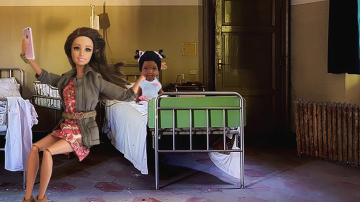5 Ways To Tell If You Have White Savior Complex
We’re living in a time where the terms “woke” and “problematic” have become colloquial shorthand to describe almost any and all behavior

Photo: Instagram/barbiesavior
We’re living in a time where the terms “woke” and “problematic” have become colloquial shorthand to describe almost any and all behavior. A simple social media search will show that the culture has developed a way of assigning almost anything to either category quickly and unflinchingly.
Babies in cages? Problematic, at least. Intersectional feminism? Woke AF. White supremacy? Problematic. White allies? Woke AF.
But, does everything fit neatly into one or the other category of social critique? The Instagram account @NoWhiteSaviors has started an important conversation around one cultural phenomenon — white saviorism — that while seemingly harmless, is in fact, an extension of privilege and white supremacy. On its face and with some audiences, it can pass as a woke attempt to uplift black and brown communities; yet it has a darker reality that is unequivocally problematic.
This Black History Month, we break down five signs of White Savior Complex, a pathology of white saviorism that many Western citizens (including POC) subscribe to, based on what we’ve learned from the experts at No White Saviors (NWS).
wp_*posts
Assuming Your Culture Knows Best
The internet collectively sighed when they witnessed viral footage of Lindsay Lohan following and reprimanding (and subsequently being almost knocked out by) a Syrian family because she assumed they were kidnapping two boys who actually happened to be the parents’ young sons. While some commenters immediately sensed the problematic nature of the situation, others expressed concern that Lindsay was a victim who was just trying to help.
However, one of the core things we’ve learned from NWS is how often white and Western people assume we know what is right for every family in every situation — even those we meet on the street in a country and culture that is not our own. Lohan’s actions demonstrated an assumption that she, as a wealthy white woman, understood completely the dynamics of the family and what was best for the children involved.
The hubris that fueled that belief was quintessential “white savior” pathology in action.
wp_*posts
“Trying On” Other People’s Lives Temporarily
From Teach for America to Haiti missionary trips, No White Saviors points out how “[White saviors], and the institutions that send them [into global non-white communities], operate from a deficiency-based, ‘white man’s burden’ model: these children are lacking/broken and I’m here to enhance/fix their lives. They use racist tropes as a means of connecting with kids then retreat back into white fragility when called out on it.”
Many of the people doing this work show up for a limited period with promises to connect with black and brown children and offer them hope for a better future. The reality, however, is that they are part of a rotating cast of characters who enter these children’s lives, attempt to relate to them for a short period, and then move on at the end of their missionary trip or volunteer term. They “try on” culture and a life that is, for these children, a reality; then they “take it off” when they’re ready, often causing more psychological harm to the children and communities they visit than if they never came in the first place.
wp_*posts
Offering Unhelpful, Cumbersome Aid and Expecting Gratitude In Return
https://www.instagram.com/p/BpGYah7HlQM/
Western traditions of giving typically look like heaps of donated food, clothing, and supplies. Yet so often, people take these drives as an opportunity to dump old, unnecessary, or unusable items from their home — making it someone else’s burden.
Organizations like TOMS and others have been called out time and again for creating a cycle in which aid organizations receive more of what they don’t need than that of what they’ve asked for (i.e. tons of shoes for children, but no sustainable help in the form of food, education, and other resources). This results in more work for the organizations, both continuing their search to find what they’re in need of and determining how to sift through and discard the things they do not.
The assumption that “these people will be happy with anything” can be misguided and arrogant.
“If it’s trash and you’d be offended if someone donated it to you, PLEASE don’t send that sh*t here either,” No White Saviors sums up on their Instagram page.
wp_*posts
Speaking Over or Speaking “For” People Who Are “Voiceless”
https://www.instagram.com/p/BpgmYAzhv3Q/
We’ve all heard the term “voice for the voiceless,” but No White Saviors makes it clear that voiceless people are made that way by those who do not give them a platform to speak.
While we often celebrate those who use their platform to bring awareness to various issues, we rarely see these people offer up their platform to those who have a lived-in knowledgable experience with the issues.
The most important thing platform holders must do is allow themselves to be led by those who need help. Many marginalized groups are in fact not helpless about what to do about their situations, they’re simply in need of ears to listen and platforms to amplify and support their solutions.
wp_*posts
Participating in or Spreading “Poverty Porn”
Even those who travel to other communities to provide aid with the best intentions can undermine their own intentions when they commit this one common, yet dangerous, act: snapping the cliché photo of themselves holding a small black or brown baby in their arms.
No White Saviors coined these photos as “poverty porn,” images that depict Western “saviors” as the hero and the children as the impoverished, struggling supporting character. It centers the aid worker in the situation and shifts the conversation to how they are “such a good person,” rather than putting the focus on the real need. Additionally, it perpetuates a narrative that all black and brown babies are dependent upon white or Western aid to feel safety, security, and comfort.

















